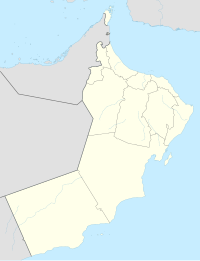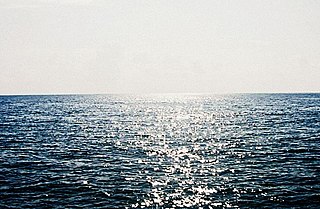
The Arabian Sea is a region of sea in the northern Indian Ocean, bounded on the west by the Arabian Peninsula, Gulf of Aden and Guardafui Channel, on the northwest by Gulf of Oman and Iran, on the north by Pakistan, on the east by India, and on the southeast by the Laccadive Sea and the Maldives, on the southwest by Somalia. Its total area is 3,862,000 km2 (1,491,000 sq mi) and its maximum depth is 4,652 meters (15,262 ft). The Gulf of Aden in the west connects the Arabian Sea to the Red Sea through the strait of Bab-el-Mandeb, and the Gulf of Oman is in the northwest, connecting it to the Persian Gulf.

The Gulf of Oman or Sea of Oman, also known as Gulf of Makran or Sea of Makran, is a gulf that connects the Arabian Sea with the Strait of Hormuz, which then runs to the Persian Gulf. It borders Iran and Pakistan on the north, Oman on the south, and the United Arab Emirates on the west.

A trade route is a logistical network identified as a series of pathways and stoppages used for the commercial transport of cargo. The term can also be used to refer to trade over bodies of water. Allowing goods to reach distant markets, a single trade route contains long-distance arteries, which may further be connected to smaller networks of commercial and noncommercial transportation routes. Among notable trade routes was the Amber Road, which served as a dependable network for long-distance trade. Maritime trade along the Spice Route became prominent during the Middle Ages, when nations resorted to military means for control of this influential route. During the Middle Ages, organizations such as the Hanseatic League, aimed at protecting interests of the merchants and trade became increasingly prominent.

The Port of Singapore is the collection of facilities and terminals that conduct maritime trade and handle Singapore's harbours and shipping. It has been ranked as the top maritime capital of the world, since 2015. Currently the world's second-busiest port in terms of total shipping tonnage, it also transships a fifth of the world's shipping containers, half of the world's annual supply of crude oil, and is the world's busiest transshipment port. It was also the busiest port in terms of total cargo tonnage handled until 2010, when it was surpassed by the Port of Shanghai.

The Port of Hong Kong located by the South China Sea, is a deepwater seaport dominated by trade in containerised manufactured products, and to a lesser extent raw materials and passengers. A key factor in the economic development of Hong Kong, the natural shelter and deep waters of Victoria Harbour provide ideal conditions for berthing and the handling of all types of vessels. It is one of the busiest ports in the world, in the three categories of shipping movements, cargo handled and passengers carried. This makes Hong Kong a Large-Port Metropolis.

Muttrah, administratively a wilayah (province), is located in the Muscat Governorate of Oman. Before the discovery of oil in Oman, Muttrah was the center of commerce in Oman (Muscat). It is still a center of commerce as one of the largest sea ports of the region is located there. Other landmarks include Souq Muttrah, a traditional bazaar and Sour Al-Lawatiah, a small community of houses surrounded by an old wall. To the south lies Muscat District.

Salalah is the capital and largest city of the southern Omani governorate of Dhofar. At the 2020 census, it had a population of 331,949.
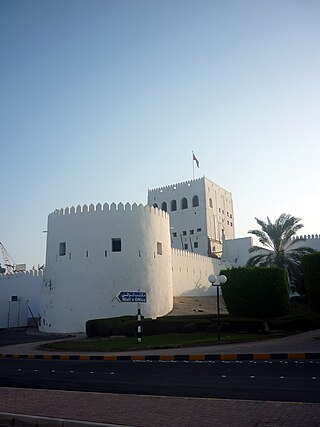
Sohar is the capital and largest city of the Al Batinah North Governorate in Oman. An ancient capital of the country that once served as an important Islamic port town, Sohar has also been credited as the mythical birthplace of Sinbad the Sailor. It was historically known as Mazun.
Khor Fakkan is a city and an exclave of the Emirate of Sharjah, located on the east coast of the United Arab Emirates (UAE), facing the Gulf of Oman, and geographically surrounded by the Emirate of Fujairah. The city, the second largest on the east coast after Fujairah City, is set on the bay of Khor Fakkan, which means "Creek of Two Jaws". It is the site of Khor Fakkan Container Terminal, the only natural deep-sea port in the region and one of the major container ports in the UAE. The Port of Khor Fakkan faces the Emirate of Sharjah’s eastern seaboard, extending connections with Asia and the Far East. This port is one of the Emirate’s three ports.
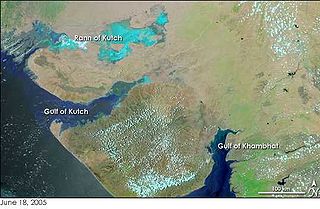
Indian maritime history begins during the 3rd millennium BCE when inhabitants of the Indus Valley initiated maritime trading contact with Mesopotamia. As per Vedic records, Indian traders and merchants traded with the far east and Arabia. During the Maurya Empire, there was a definite "naval department" to supervise the ships and trade. At the end of 1st century BCE Indian products reached the Romans during the rule of Augustus, and the Roman historian Strabo mentions an increase in Roman trade with India following the Roman annexation of Egypt. As trade between India and the Greco-Roman world increased, spices became the main import from India to the Western world, bypassing silk and other commodities. Indians were present in Alexandria while Christian and Jewish settlers from Rome continued to live in India long after the fall of the Roman Empire, which resulted in Rome's loss of the Red Sea ports, previously used to secure trade with India by the Greco-Roman world since the Ptolemaic dynasty. The Indian commercial connection with Southeast Asia proved vital to the merchants of Arabia and Persia during the 7th–8th century. A study published in 2013 found that some 11 percent of Australian Aboriginal DNA is of Indian origin and suggests these immigrants arrived about 4,000 years ago, possibly at the same time dingoes first arrived in Australia.

The Gwadar Port is situated on the Arabian Sea at Gwadar in Balochistan province of Pakistan and is under the administrative control of the Maritime Secretary of Pakistan and operational control of the China Overseas Port Holding Company. The port features prominently in the China–Pakistan Economic Corridor (CPEC) plan, and is considered to be a link between the Belt and Road Initiative and the Maritime Silk Road projects. It is about 120 kilometres (75 mi) southwest of Turbat, and 170 kilometres (110 mi) to the east of Chabahar Port.

Jeddah Islamic Port is a Saudi Arabian port, located in Jeddah on the Red Sea, at the middle of an international shipping route between the east and west via the Suez Canal. It is the second-largest and second-busiest port in the Arab world. The city of Jeddah is the second-largest city in Saudi Arabia, and is Saudi Arabia's commercial capital.

The Port of Shanghai, located in the vicinity of Shanghai, comprises a deep-sea port and a river port.

China Merchants Port Holdings Company Limited is a major conglomerate based in Hong Kong and is involved in a range of businesses such as port operations, general and bulk cargo transportation, container and shipping business, air cargo, logistics park operations and paint products. China Merchants Port is considered as a Red Chip company as the Hong Kong Stock Exchange listing. The company has port facilities in mainland China and Hong Kong, and the predecessor was founded in 1991. The predecessor of the parent company was established in 1872 and was the preeminent industrial and commercial group in mainland China. Before changing its name to China Merchants Port Holdings Company Limited, the company was formerly known as China Merchants Holdings (International) Company Limited.

The Port of Duqm, also known as Duqm Port, is a seaport and road terminal located at Duqm in the Al Wusta governorate of Oman. Duqm Port, integrated in the Special Economic Zone at Duqm (SEZAD), and located 550 kilometres south of capital Muscat, is equipped with a ship repair yard and dry dock facility. Overlooking the Arabian Sea and the Indian Ocean, the Port of Duqm is a joint-venture between ASYAD Ports and Consortium Antwerp Port. Although operating since 2012, it was not officially opened until 4 February 2022 by Mr. Asa'ad bin Tariq Al Said, Deputy Prime Minister for International Relations and Cooperation Affairs and Personal Representative of His Majesty the Sultan of Oman.
Khalifa Port is the Abu Dhabi Ports' flagship deepwater port. It is a gateway to Abu Dhabi and handles all of the emirate’s container traffic. The transfer of container traffic from Zayed Port was completed in December 2012.
SOHAR Port and Freezone is a deep-sea port and adjacent free zone in the Middle East, located in Sohar, Sultanate of Oman, midway between Dubai and Muscat. With current investments exceeding $26 billion, it is one of the world's fastest growing port and free zone developments and lies at the centre of global trade routes between Europe and Asia.
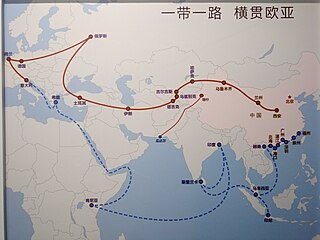
The 21st Century Maritime Silk Road, commonly just Maritime Silk Road (MSR), is the sea route part of the Belt and Road Initiative which is a Chinese strategic initiative to increase investment and foster collaboration across the historic Silk Road.

King Abdul Aziz Port, also known as Dammam Port, is a port in the city of Dammam, Saudi Arabia. It is the largest port in the Persian Gulf, and the third largest and third busiest port in the Middle East and North Africa (MENA) region, after the Jeddah Islamic Port. King Abdul Aziz Port is a major export center for the oil industry, and also a key distribution center for major landlocked cities in the country, particularly the capital cities of provinces, such as Riyadh which is linked to Dammam by a railway line.

The Maritime Silk Road or Maritime Silk Route is the maritime section of the historic Silk Road that connected China, Southeast Asia, the Indian subcontinent, the Arabian peninsula, Somalia, Egypt and Europe. It began by the 2nd century BCE and flourished later on until the 15th century CE. Major players in the Maritime Silk Road include the merchants from the Tang, Song, Yuan and Ming dynasties of imperial China, Austronesian sailors in Southeast Asia, Tamil merchants in India and Southeast Asia, and Persian and Arab traders in the Arabian Sea and beyond. The network followed the footsteps of older maritime networks in Southeast Asia, as well as the maritime spice networks of Southeast Asia, Sri Lanka, India, and the Indian Ocean, coinciding with these ancient maritime trade roads by the current era.

